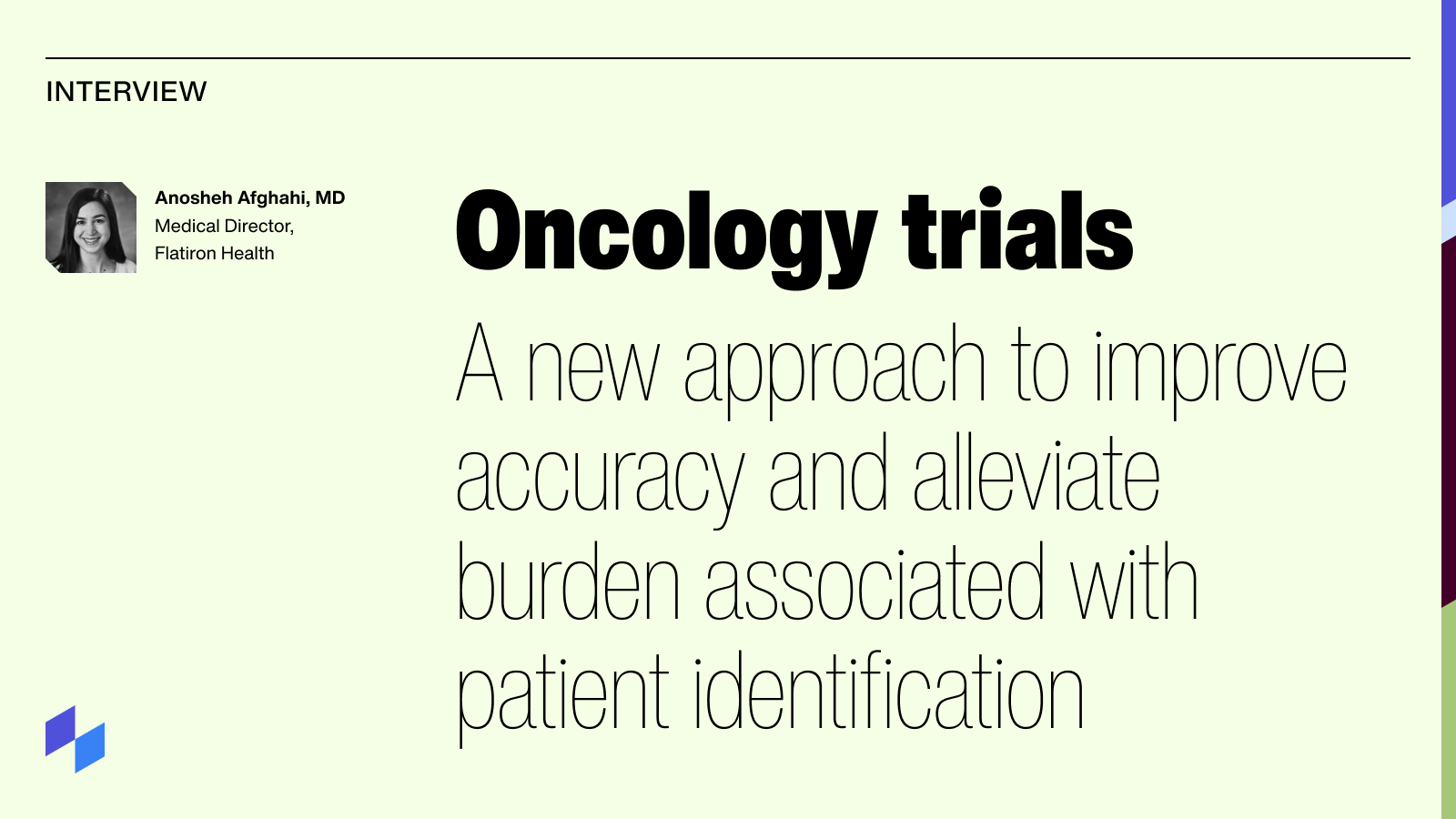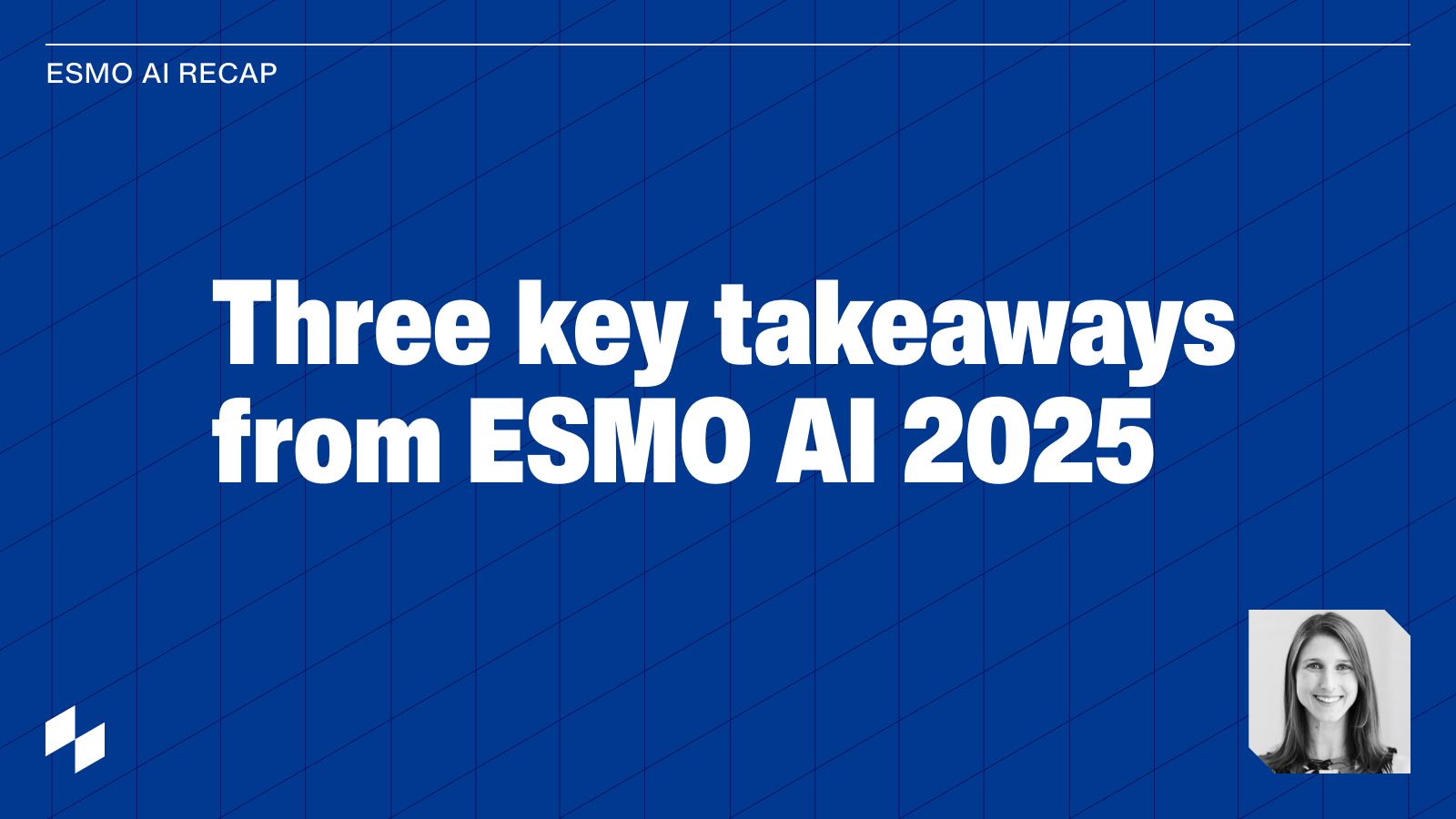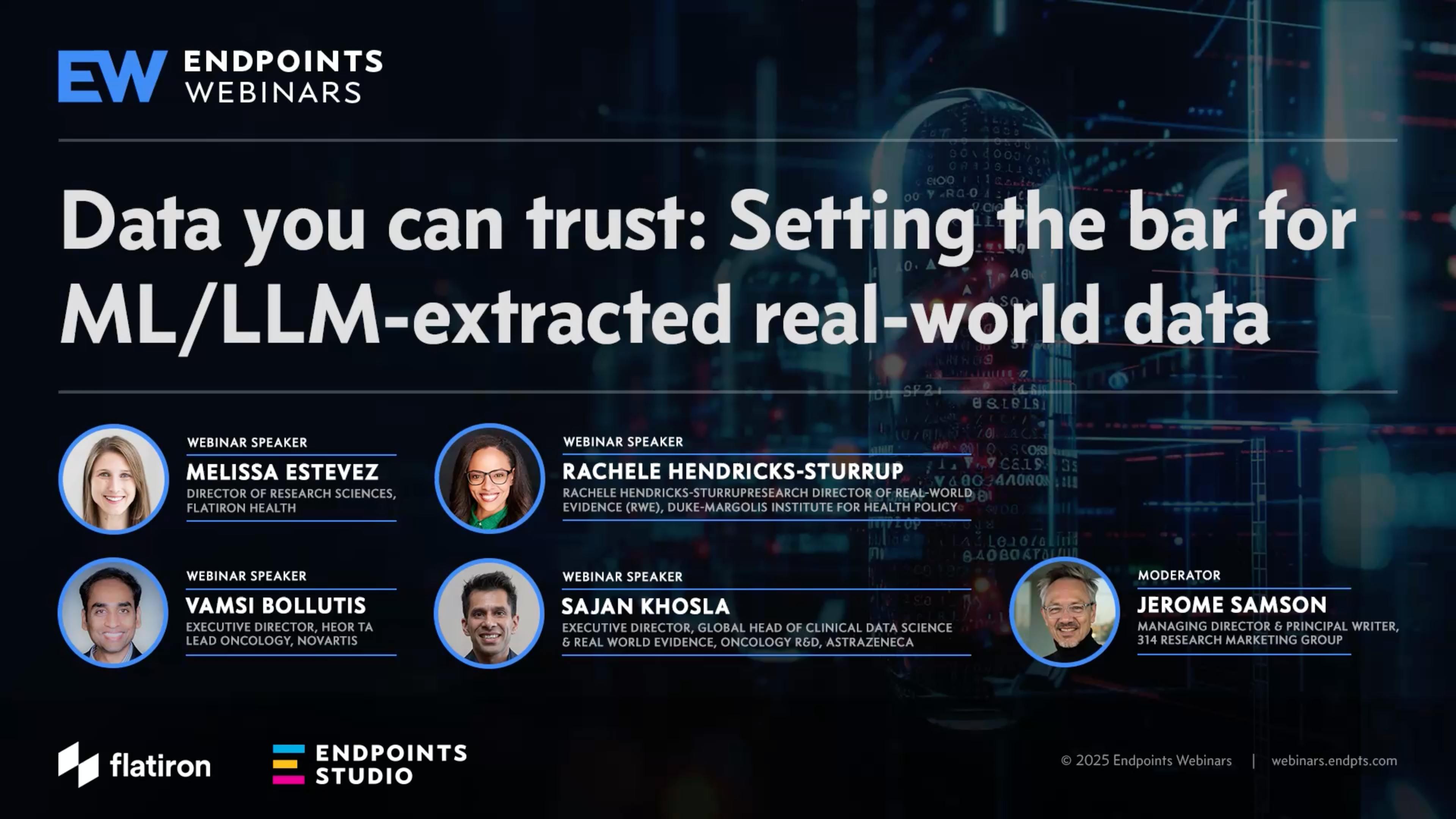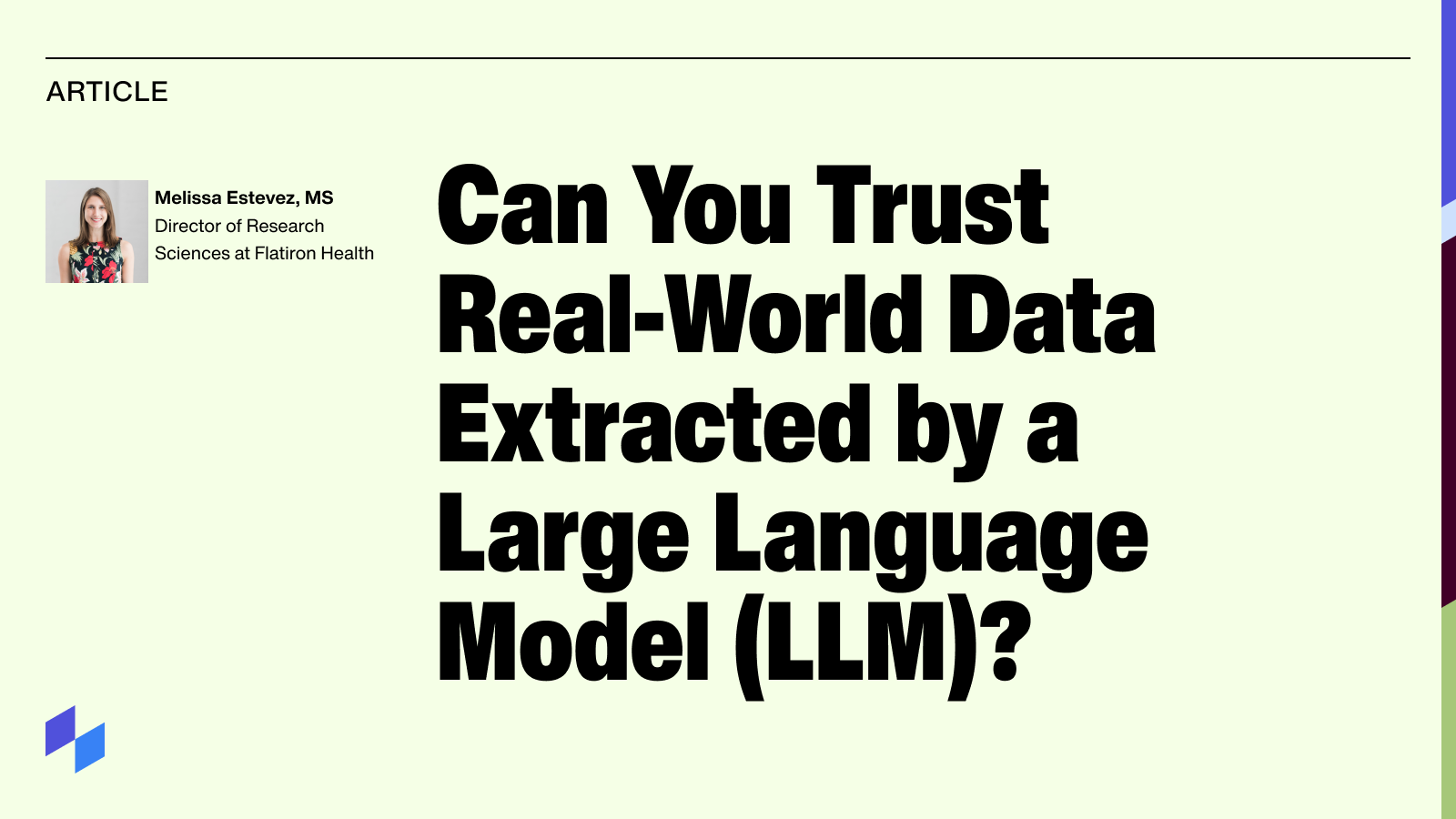An interview with Flatiron Medical Director, Dr. Anosheh Afghahi
The last twenty years have seen remarkable breakthroughs in the understanding, diagnosis, treatment and prevention of cancer, and the rate of regulatory approval for new targeted treatments and therapeutic approaches is accelerating.1 Across many types of cancers, patients benefit from substantially better outcomes today than their parents ever did. But continued progress hinges on efficient clinical trials, and there are serious concerns in the research community that clinical trials are getting too complex — and therefore too costly and time-consuming — to keep up with market needs.2
Many factors can contribute to trial complexity, and some are harder to avoid than others, but patient screening is an area where there's a clear opportunity to make a difference. At the 2024 ASCO Quality Care Symposium this past September, Flatiron Health presented a new service to help sites screen patients based on a novel combination of structured EHR data, machine learning, and human abstraction.3 We talked with principal author Dr. Anosheh Afghahi about this promising new service and what it could mean for the future of cancer research.
Welcome, Dr. Afghahi, and thanks for taking the time to talk to us. Before we get into the details, could you tell us what motivated you and your team to take a closer look at patient screening?
At Flatiron, we work with many oncologists who practice in the community setting. They see thousands of patients and want to do what's best for each of them, but resources are tight. They don't always have the bandwidth nor necessary data and infrastructure to know what trials are actively recruiting, and whether they would be a good fit for their patients.
As you know, many oncology trials today are hard to recruit to, as they’re often biomarker-driven or limited to very unique patient populations due to other clinical characteristics. For instance, a patient might only be eligible within a very narrow time window, or allowed to take one drug but not another, plus a host of other complex inclusion/exclusion criteria. At Flatiron, we recognized that we had very good technology already embedded within our community oncology sites, medical oncologists like myself who could decipher protocols and understand what types of patients would be a good fit for certain studies, and teams of engineers who could code and help us redesign the whole patient identification process as a highly-efficient centralized service. And so we set out to develop those capabilities.
Do sites recognize they need help with patient screening?
Absolutely. Oncologists are very busy. Staffing, lack of resources, and high turnover rate among clinical trial coordinators all contribute to serious limitations at clinic sites, and those limitations are felt most acutely at the patient screening stage. They’re looking for a better approach to do right by their patients. Even Academic Medical Centers with dedicated research teams integrated into the oncology clinic see much value in a service that could help them accrue patients, maybe not for all trials, but for the most complex among them.
There’s plenty of room for improvement. Today, less than 10% of potentially eligible patients are enrolled to clinical trials, and therefore the vast majority of patients are not offered an opportunity to take part in an oncology trial that could make a difference in their lives, both directly (by giving them early access to an experimental drug) and indirectly (by paving the way to a newly approved therapy). We’ve worked with sites that had rescue studies without any patient accrual for extended periods, and they were able to consent new patients within a month or two of working with us.
At the ASCO Quality Care Symposium, you described this new service as a multi-modal approach to patient screening, the three modalities being: structured variables, machine learning, and human abstraction. Could you outline for us what the process flow looks like?
It all starts with structured variables in the EHR. We have to make sure for instance that patients have the right clinical characteristics for the study (including the disease type, stage, etc.) and have an oncology visit coming up soon.
We then use machine learning, if indicated per the study inclusion and exclusion criteria. Every study is different and may require more or less machine learning intervention, like categorizing unstructured data from clinical notes. This allows us to capture important data points like prior oral therapies and other critical insights that may qualify or disqualify a patient for a given trial.
And finally, we rely on human abstraction experts to analyze information from histology and biomarker testing reports, history of prior malignancies, and other criteria that need a human lens to fully decipher. This is the most time-consuming of the three modalities, but also the one where we can add the most value to the screening process.
Can you give us an example of how those three modalities play out in terms of progressively narrowing down the eligible patient population?
I can give you more than one. At the ASCO Symposium, I presented results from six very different trials, from phase 1 to phase 4. For one of those trials, we identified over 50,000 patients with an upcoming visit, narrowed down the pool of eligible patients to 171 using structured data, 160 after machine learning, and 9 after human abstraction. For a second trial, we started out with over 70,000 patients, narrowed it down to 15,000 using structured data, 5,700 after machine learning, and after human abstraction ended up with 13 eligible patients. As you can see, the screening funnel can look very different from one study to the next.
Overall, across the six trials, 91% of patients were filtered out at the first step, using structured EHR data only, and 67% of those were filtered out at the machine learning stage. That left us with about 3% for the human abstraction stage. That’s a substantial time saver when you consider what it would be like to assess every patient individually.
So, a site that only relies on structured EHR data today to screen patients would see a big difference in screening accuracy.
It would make an enormous difference. We’ve estimated that sites’ screening accuracy would jump over 94% with such a centralized service. That would certainly free up time and resources to discuss more potential trials with more patients.
And there’s another important benefit: research sponsors want a participant pool for their studies that reflects the real world, both in terms of geography and demographics, especially when it comes to race and ethnicity. We’ll have more data to share soon, but already with the six trials we examined for that initial presentation, 23% of all successfully screened patients were Black patients, a notoriously underrepresented population group in oncology trials. So while screening accuracy is the top headline, it’s very encouraging to see that a centralized patient screening process might lead to more diversity in clinical trial participation.
That’s terrific news for patients, providers and sponsors. We can’t wait to see that new data. While it’s clear that your new process can help surface eligible patients that sites might have missed before, is there any concern from sites that this might add burden to their practice?
Not when you consider that the alternative is to forgo participation in those trials. One of the big benefits of this new approach is that it minimizes over-surfacing patients. A less systematic approach might surface many more patients, forcing sites to manually assess their eligibility, only to realize that many of them weren’t eligible in the first place. That’s where the real burden would be.
Our system makes full use of the existing EMR infrastructure at the site. We use Flatiron’s own OncoEMR and OncoTrials software at the moment, but the service can be applied to other popular platforms. We use that software to pull relevant EHR data in order to assess eligibility, and once that eligibility has been confirmed, we issue real-time notifications back to the sites using EHR and email alerts. It’s up to the sites then to present the opportunity to their patients and secure consent.
Is the screening process then completely hands-off, from the site’s perspective?
Not completely. Sites are still responsible for interacting with their patients and ultimately securing their consent. We don’t communicate with their patients directly. In addition, part of the process is customized to the trial in question and to the site’s specifications. We rely on regular input from all stakeholders to make sure it meets their needs. So it’s not an outsource-and-forget type of relationship.
We have a Research Network team at Flatiron that communicates with the cancer sites daily, and sites are very comfortable relaying concerns or suggestions for improvement. We’re flexible and transparent with them. If something that we implemented doesn’t work well, we work together on a timely solution. If the process is too restrictive, or it over-surfaces patients, we make the necessary adjustments. At the end of the day, our mission is to help sites match patients to the right trial as efficiently as possible.
Can this new service be used as some sort of alert system for future eligibility as well?
It can, and in fact we’re already using it that way. If an otherwise eligible patient is missing a biomarker test, for instance, we would notify the site that this would be a good candidate to pre-screen for that trial. We also make adjustments based on the study population. Say, if these are patients with hepatocellular carcinoma where there are limited systemic therapy options and local-regional types of therapies like radiation or surgery are more common, we would never restrict their eligibility to the requirement that they visit their clinic within 30 days, because we know these patients may only come visit their oncologist every six months.
That’s where having human abstraction with practicing oncologists in the process can be a big advantage. Rather than removing those patients from the eligible pool altogether, we place them into a ‘watching’ bucket where we’re continuously reevaluating the data for future eligibility. If a visit comes up, or a scan shows evidence of progression that now makes the patient eligible, we can quickly surface that patient to the corresponding site.
What’s next?
Our first test cases for this new service showed great promise, and we want to expand that initial footprint to better quantify the benefits in terms of accuracy, speed, cost savings, but also trial access and diversity. We want to increase awareness of the service, make sure that sites and sponsors are satisfied with it, and ultimately match more eligible patients to clinical trials they’re a good fit for. So stay tuned for more news and publications from our team!
If you’re interested in more details about the first six trials that used this screening service, please check Dr. Afghahi’s poster presentation at the 2024 ASCO Quality Care Symposium. To partner with Flatiron Health and open more trial participation opportunities for your patients without adding burden to your operations, please contact our Clinical Research experts.
1. Scott, E.C., Baines, A.C., Gong, Y. et al. Trends in the approval of cancer therapies by the FDA in the twenty-first century. Nat Rev Drug Discov 22, 625–640 (2023).
2. Markey, N., Howitt, B., El-Mansouri, I. et al. Clinical trials are becoming more complex: a machine learning analysis of data from over 16,000 trials. Sci Rep 14, 3514 (2024).
3. ASCO Quality Care Symposium Proceedings (Sep 2024)



